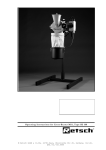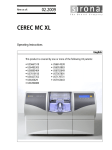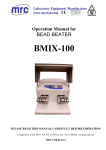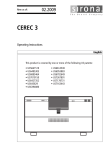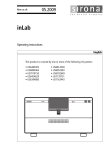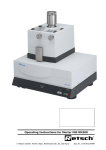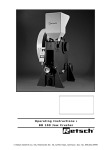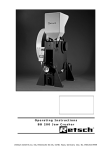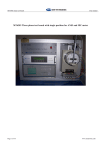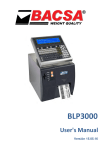Download Operating Instructions for Oscillating Mill MM400
Transcript
Operating Instructions for Oscillating Mill MM400 © Retsch GmbH, 42781 Haan, Rheinische Str.36, Germany Doc.Nr. D 98.745.9999 Notes on these operating instructions These operating instructions for the oscillating mill, type MM400, give all the necessary information on the areas mentioned in the contents. They instruct the target group(s) for each of the defined areas, in order to ensure safe handling of the MM 400 when used for the intended purpose. Knowledge of the relevant section is an essential precondition for safe, proper use of the machine. This technical documentation is a reference work and also a set of teaching instructions. The individual sections are complete in themselves. These operating instructions do not include instructions for repairs. In case of possible defects or necessary repairs please contact your suppliers or Retsch GmbH direct: Retsch GmbH, www.retsch.de/ 17.07.2007 2 © Retsch GmbH Doc.Nr.D98.745.9999 Contents Notes on these operating instructions .................................... 2 Contents.................................................................................. 3 Safety ..................................................................................... 4 Safety instructions ...........................................................................4 Warning signs .................................................................................5 Repairs...........................................................................................5 Confirmation ...................................................................................8 Technical data ......................................................................... 9 Use according to the intended purpose................................................9 Protective equipment...................................................................... 10 Emissions ..................................................................................... 10 Protective systems ......................................................................... 11 Rated power: ................................................................................ 11 Machine dimensions ....................................................................... 11 Required floor space....................................................................... 11 Transport and installation ..................................................... 11 Packing ........................................................................................ 11 Transport...................................................................................... 11 Intermediate storage...................................................................... 11 Supply schedule ............................................................................ 12 Conditions for the place of installation............................................... 12 Installation ................................................................................... 12 Electrical connection....................................................................... 13 Operation .............................................................................. 14 Operating elements and operation .................................................... 14 Graphical representation ................................................................. 14 General table ................................................................................ 15 Display and operating unit............................................................... 16 Inserting / replacing the milling cups ................................................ 17 Setting the milling time .................................................................. 17 Setting the frequency ..................................................................... 18 Starting the milling process ............................................................. 18 Stopping the milling process ............................................................ 18 Storing the milling parameters......................................................... 19 Operating hours display .................................................................. 19 Operating software display .............................................................. 20 Replacing the machine fuses............................................................ 20 Working instructions............................................................. 20 General ........................................................................................ 20 The milling process ........................................................................ 21 Quantities of milling material and grain sizes ..................................... 21 Safety instructions for handling liquid nitrogen ................................... 22 Safety functions and fault displays ....................................... 23 Safety functions............................................................................. 23 General ................................................................................. 24 Cleaning ....................................................................................... 24 Maintenance.................................................................................. 24 Wear............................................................................................ 24 Wearing parts................................................................................ 24 Checks ......................................................................................... 24 Copyright ..................................................................................... 24 Alterations .................................................................................... 25 Accessories for MM 400................................................................... 25 Safety regulations for the MM 400 - summary .................................... 26 Warranty Conditions ............................................................. 27 17.07.2007 3 © Retsch GmbH Doc.Nr.D98.745.9999 Safety Target group: All persons concerned machine in any way with the The MM 400 is a modern, highly efficient product of Retsch GmbH, corresponding to state of the art. If the machine is used according to the intended purpose with a knowledge of this technical documentation it is completely safe and reliable to operate. Safety instructions As the operating authority it is your duty to ensure that all persons charged with working on the MM 400: • have read and understood all the instructions on safety, • before beginning work know all the instructions and regulations for the target group relevant to their work, • have access to the technical documentation for this machine at all times, without problems. • New personnel should be familiarized with safe, proper handling of the machine before beginning work on the MM 400, either by verbal instruction from a competent person or through this technical documentation. • Improper operation can cause injury to persons or damage to the equipment. You are responsible for your own safety and that of your employees. • Ensure that no unauthorised persons have access to the MM 400. For your own protection have your employees confirm that they have been instructed in operation of the MM 400. The draft of a suitable form is given at the end of the section on safety. We exclude any claims for damages of any kind for injury to persons and damage to equipment arising from non-observance of the following safety instructions. 17.07.2007 4 © Retsch GmbH Doc.Nr.D98.745.9999 Warning signs Warnings are given by the following signs: Injury to persons Damage to equipment Observe instructions for use Repairs These operating instructions do not include repair instructions. For your own safety repairs must be carried out only by Retsch GmbH or an authorised agent (service technicians). In this case please contact: The Retsch agency in your country Your supplier Retsch GmbH directly Your service address: ____________________________________ ____________________________________ ____________________________________ ____________________________________ 17.07.2007 5 © Retsch GmbH Doc.Nr.D98.745.9999 Safety instructions We exclude any liability for claims for damages in any form whatsoever for injury to persons or damage to the machine caused through non-observance of the following safety instructions. Use according to the intended purpose Do not make any alterations to the machine and use only spare parts and accessories approved by Retsch. Otherwise the Declaration of Conformity with European directives made by Retsch will lose its validity. Furthermore this will also lead to the loss of any guarantee claims. Packing materials Please keep the packing material for the duration of the guarantee period, since, in case of a complaint and return of the machine in unsuitable packing material your guarantee claim will be at risk. Transport The MM 400 must not be jolted, shaken or thrown during transport. Otherwise the electronic and mechanical components may be damaged. Temperature variations If subjected to high temperature variations (e.g. during transport by aircraft) the MM 400 must be protected against condensed water. Otherwise the electronic components may be damaged. Supply schedule If the delivery is incomplete and/or transport damage is found, you must inform the transporter and Retsch GmbH immediately (within 24 hrs). Later complaints may possibly be no longer considered. Conditions for the place of installation If the temperature drops below or exceeds the ambient temperature the electronic and mechanical components may be damaged; the performance data are then altered to an unknown extent. At high atmospheric humidity the electronic and mechanical components may be damaged and the performance data are altered to an unknown extent. Electrical connection If the values on the rating plate are not observed the electrical and mechanical components may be damaged. Inserting / replacing the milling cups Ensure that the milling cups are inserted correctly in the milling cup holder – otherwise they can become damaged when starting the machine. Both milling positions must always be used since otherwise this will cause considerable unbalance. When removing and opening hot milling cups always wear protective gloves. Danger of burning the hands. General Observe the relevant regulations and directives of your country for handling chemicals and hazardous materials. Apply these when working with the MM 400. Materials Milling of materials with the MM 400 which give a risk of fire or explosion is prohibited. Please take the necessary measures, depending on the hazardous nature of your sample, to prevent danger to persons. Note also that the properties, and therefore the hazardous nature of your sample, can change during the milling process. 17.07.2007 6 © Retsch GmbH Doc.Nr.D98.745.9999 Safety instructions for handling liquid nitrogen Always wear protective goggles and protective gloves when handling liquid nitrogen. Liquid nitrogen has a temperature of –196°C and can cause frostbite or injury similar to burns if it comes into contact with the skin or eyes. Follow the safety regulations of the cooling liquid supplier. Retsch GmbH accepts no liability whatsoever arising from the use of liquid nitrogen or similar materials. Cleaning Do not clean the MM 400 under running water. Danger to life through current surge. Use only a cloth moistened with water. Cleaning agents and solvents should not be used – not for cleaning the milling tools either. Accessories for the MM 400 Do not make any alterations to the machine and use only spare parts and accessories approved by Retsch. Otherwise the Declaration of Conformity with European directives made by Retsch will lose its validity. Furthermore this will also lead to the loss of any guarantee claims. Wearing parts These operating instructions do not include any repair instructions. For your own safety repairs should be carried out only by Retsch GmbH or an authorised agent (service technicians). 17.07.2007 7 © Retsch GmbH Doc.Nr.D98.745.9999 Confirmation I have taken note of the sections „Notes on these operating instructions” and “Safety” _______________________________________ Signature of operating authority _______________________________________ Signature of service technician 17.07.2007 8 © Retsch GmbH Doc.Nr.D98.745.9999 Technical data Target group: Operating authority, operator Machine type designation: MM 400 Use according to the intended purpose The MM 400 is a laboratory machine and is suitable for milling and homogenising soft, fibrous, hard and brittle materials in the wet and dry state. The MM 400 is designed for use with screw-type milling cups with a steel casing and a milling set with clamping centerings of dia. 36 mm and a min. clamping length of 60 mm. It is used for fast, super fine milling of 2 samples simultaneously. Ceramic milling cups without a complete steel casing must not be used. The closed milling system guarantees complete recovery of the samples. Owing to the extremely short milling time and the high final fineness of the material to be milled the MM 400 is also ideally suitable for sample preparation for all spectral analyses. Final finenesses of down to 1 µm can be achieved, depending on the milling time and the specific properties of the sample material. The optimum milling cup filling is as a rule 1/3 of the milling cup volume. Exceptions to this are voluminous materials, such as wool, leaves, grasses and suchlike. In these cases a filling level of 70-80% is necessary. The sample quantity should not be less than 25% of the milling cup volume. The milling ball/s may otherwise damage the milling cups. The milling cup materials and milling ball materials must always be identical. The milling ball/s may otherwise damage the milling cups. Do not make any alterations to the machine and use only spare parts and accessories approved by Retsch. Otherwise the Declaration of Conformity with the European directives by Retsch loses its validity. Futhermore this will result in the loss of any kind of guarantee claim. Do not clamp any ceramic milling cups of the MM 2/200 or any milling cups without a complete steel casing. Clamping by the metallic components of the milling cup holder of the MM 400 can cause damage to the ceramic parts. 17.07.2007 9 © Retsch GmbH Doc.Nr.D98.745.9999 Do not use ceramic or natural stone milling cups for milling graphite or graphite mixtures. The high lubricating properties of graphite cause high milling ball speeds, the energy of which cannot be absorbed by the material owing to its low density. For this reason there is a danger that the ceramic or natural stone inserts of the milling cups will be destroyed by the ball/s. For further information our application laboratory will be pleased to assist you. Protective equipment The milling chamber of the laboratory mill MM 400 is enclosed by a strong covering hood. Starting the machine is possible only with the hood closed. Emissions Noise characteristic values : The noise characteristic values are also influenced by the properties of the material to be milled. Example 1: Intensity of sound LWA = 71.4 dB(A) Emission value related to = 61 dB(A) workplace LpAeq Operating conditions: Container: 2 steel milling cups of 25 ml Milling organ: Material charged: 1 steel ball 20 mm Quartz crushed pebbles approx. 4.0 – 6.0 mm Charged quantity: 8ml Example 2: Intensity of sound LWA = 76 dB(A) Emission value related to = 65 dB(A) workplace LpAeq Operating conditions: Container: Milling organ: Material charged: Charged quantity: 17.07.2007 10 2 steel milling cups of 5 ml 2 tungsten carbide balls 8 mm Quartz crushed pebbles approx. 1.0 – 1.5 mm 1.5ml © Retsch GmbH Doc.Nr.D98.745.9999 Protective systems IP30 Rated power: 150 Watt Machine dimensions Height: Width: Depth: 266 mm up to approx. 524 mm with hood opened 371 mm 461 mm Weight: approx. 26 kg without milling cups Required floor space 400 mm x 500 mm; no safety distance required. Transport and installation Target group: operating authority, transporter, operators Packing Packing is adapted to the transport route and conforms to generally applicable packaging guidelines. Please keep the packing material for the duration of the guarantee period since if there is a complaint and the machine is returned with inadequate packing your guarantee claim will be at risk. Transport The MM 400 must not be knocked, shaken or thrown during transport. Otherwise the electronic and mechanical components can become damaged. Temperature variations If temperature variations are high (e.g. during air transport) the MM 400 must be protected against condensed water. Otherwise the electronic components can become damaged. Intermediate storage Ensure that the MM 400 is also stored dry during intermediate storage. 17.07.2007 11 © Retsch GmbH Doc.Nr.D98.745.9999 Supply schedule • MM 400 • 1 power supply cable • 1 set of operating instructions Check completeness of the delivery, including individually ordered accessories. Check perfect functionability of the MM 400 (see also section on operation). If the delivery is incomplete and / or there is transport damage you must inform the transporter and Retsch GmbH immediately (within 24 hrs). Later complaints may possibly be no longer considered. Conditions for the place of installation Ambient temperature: 5°C to 40°C If the ambient temperature drops below or exceeds these values the electronic and mechanical components can become damaged and performance data are changed to an unknown extent. Atmospheric humidity: Maximum relative humidity 80% at temperatures up to 31°C, decreasing linearly down to 50% relative humidity at 40°C. At higher atmospheric humidity the electronic and mechanical components can become damaged and performance data are changed to an unknown extent. Installation height: max. 2000 m above sea level Installation Mount the MM 400 on a firm, stable laboratory bench since otherwise vibrations can be transmitted. 17.07.2007 12 © Retsch GmbH Doc.Nr.D98.745.9999 Remove transport safeguard: A transport safeguard, which is marked with an arrow, is located on the underside of the MM 400. • Unscrew the screw and remove. • Keep the transport safeguard device for transport at a later date. Operation with the transport safeguard or transport without the transport safeguard can cause damage to the mechanical components. Electrical connection • The voltage and frequency for the MM 400 are given on the type plate. • Ensure that these values correspond to the available power supply system. • Connect the MM 400 to the power supply system using the supplied connection cable. • Protection by external fusing is to be used when connecting the mains cable to the power supply, according to the regulations at the place of installation. If the values on the type plate are not observed this can result in damage to the electrical and mechanical components. 17.07.2007 13 © Retsch GmbH Doc.Nr.D98.745.9999 Operation Target group: operators Operating elements and operation Graphical representation A Plan view B C D Front view 17.07.2007 14 © Retsch GmbH Doc.Nr.D98.745.9999 E I F J G H K Rear view General table Element Description Function A Display and operating unit: for explanation see below Time preselection, frequency preselection, programme and starting / stopping the machine B Hood Closes the milling chamber C Milling cup holder - left Holds the milling cup D Milling cup holder - right Holds the milling cup E Switch ON / OFF For switching the MM 400 on and off F Fuse compartment Takes two visible type fuses G Machine socket Connection for power cable of machine H Interface RS232 Enables operating software to be updated I Sign – Caution! unplug mains plug Safety instruction J Type plate Information on the machine and connected loads K Sign – Follow operating instructions Safety instruction 17.07.2007 15 © Retsch GmbH Doc.Nr.D98.745.9999 Display and operating unit L M N P O Element Description L Memory , operating mode and stand-by The various operating modes, such as on, programme and stand-by are displayed here. PROG Calls the stored programmes SET Stores the set milling parameters Frequency display The frequency can be set continuously from 3 to 30 Hz here. Frequency – minus button In the on mode and in the operating mode: Reduction of the set frequency by 0.1 oscillaltions. Continuous pressing switches on the digits fast running. Frequency – plus button In the setting mode and operating mode: Increase of the set freuqency by 0.1 oscillations. Continuous pressing switches on the digits fast running. Time display Shows the set milling time or, during operation, the milling time still remaining. Setting range: 10 seconds to 99 minutes. Time – minus button In the on mode and operating mode: Reduction of the set milling time by one second. Continuous pressing switches on the digits fast running. Time – plus button In the on mode and operating mode: Increase of the set milling time by one second. Continuous pressing switches on the digits fast running. Start – button Starts the milling operation Green LED Indicates milling operation Stop – button Interrupts or ends the milling operation, Red LED and ON Puts the machine into stand-by mode M N P O 17.07.2007 Function 16 © Retsch GmbH Doc.Nr.D98.745.9999 Inserting / replacing the milling cups Place the milling cups, filled with the material to be milled and the milling balls, into the centering points Z of the clamping device and clamp firmly. Fig.1/2 SB • Remove the locking pin SB upwards from the groove and turn through 90°. Fig.1/2 This unlocks the locking device. Abb.1 Z SB Z Abb.2 HD • Turn the handwheel HD counterclockwise until the max. clamping range is reached. Fig.1/2 • Turn the locking pin SB back through 90° until it engages in the groove again. • Insert milling cup and press lightly into the centering point Z • Turn the handwheel HD clockwise with two fingers until the milling cup just fits, free of play, in the holder. Then continue to turn the handwheel clockwise through 8 – 12 easily audible “clicks”, while at the same time the locking pin SB is raised and lowered with clearly audible “clicks”. The engaged locking pin reliably prevents automatic opening of the milling cup holder. If the locking pin SB cannot be pulled upwards to release it, unlocking should not be forced with a hammer or similar tool. Otherwise the hardened locking pin can break off. Briefly retension the handwheel HD in the clockwise direction – the locking pin can then move freely again. To remove the milling cup lift the locking pin and turn the handwheel in the opposite direction to tighten. In order to guarantee quiet running of the MM 400 both milling positions must be loaded with approximately the same mass. Ensure that the milling cups are inserted correctly in the guides. Otherwise the milling cup will be damaged when the machine is started. When removing and opening hot milling cups always wear protective gloves. Danger of burning the hands. Setting the milling time • Switch on the MM 400 with switch D Preselect time: • Set required milling time with + / - buttons N+ and N• Short pressing of N+ or N- adjusts the time by one second or one minute. When pressed for longer the display runs continuously without a pause. N- 17.07.2007 N+ If 99.0 minutes is exceeded the display L shows 0.10 seconds again. 17 © Retsch GmbH Doc.Nr.D98.745.9999 Setting the frequency • Set the frequency with + / - buttons M+ and M-. • Short pressing of + or – adjusts the frequency in single steps. With longer pressing the display runs faster. Selectable frequency range is from 3 to 30 Hz. M- M+ Starting the milling process • Shut the hood. • Set the frequency. • Set the time. • The milling operation is started with start button P. N P O • The milling time is recorded and the milling time still remaining is shown in display N. The milling process can be started only when the hood is closed. Stopping the milling process • Press the stop button O. • Pressing once interrupts the milling process, for example in order to assess the milled material. The milling time still remaining is still visible in the display N. By repressing the start button the mill continues to run until the milling time has completely elapsed. • Pressing the stop button twice stops the milling process. The machine is now in the stand-by mode. • Pressing the start button reactivates the display and the milling time is reset to the last starting value. During the milling process the time can be adjusted by pressing the N+ or N- button. When the milling time has elapsed the milling process is automatically ended. The display is reset to the last started value. 17.07.2007 18 © Retsch GmbH Doc.Nr.D98.745.9999 Storing the milling parameters Storing or calling the preselected milling parameters can be carried out only in the on mode. After switching on the MM 400 “on” appears in the display L. PROG By pressing the button PROG the next programme position P1 to P9 can be obtained. After programme position P9 „on“ reappears in the display. In the PROG mode all buttons, apart from PROG, START and STOP are blocked. SET L • When the display shows on the frequency M and time N are freely adjustable. • When the display shows P1 to P9 milling parameters can be stored and called • Start = the milling process is started with the selected programme or the parameters freely selected under „on“ . Allocating the storage location • Press button PROG once or several times until the required storage location P1-P9 has been reached. • Press SET button – all displays flash. • Set frequency M and time N. The programming mode can be discontinued by pressing the button PROG – the values are not stored. • Press SET button – the values are stored. Flashing of the display stops, the adjustment interlock is activated and the milling parameters are stored. Operating hours display If the buttons described below are pressed in the stand-by mode the complete running time of the machine is shown in hours and minutes. Display operating hours : • Press buttons M+ and SET simultaneously and keep pressed. “bS” appears in the display “memory”. Leave operating hours : • Press STOP button. hhh 17.07.2007 hhh 19 © Retsch GmbH Doc.Nr.D98.745.9999 Operating software display When the buttons described below are pressed in the stand-by mode the actual software version is displayed. Display operating software: • Press buttons M- and SET simultaneously and keep pressed. „S“ appears in the display „memory“ and the actual software version appears in the display “frequency 1/s”. Leave operating software display : • Press STOP button. Replacing the machine fuses B A The following visible type fuses are required for the MM 400: 2 MT 3.15 A fuses Replacing the fuses • Unplug mains plug from the machine socket A • By pressing the locking devices on the side of the fuse compartment B these are released and can be pulled out. • Replace fuses • Insert fuse holder B so that it engages. Working instructions Target group: operators General The MM 400 is an ultramodern, high performance product from Retsch GmbH. Owing to the large selection of accessories the oscillation mill, type MM 400, is a machine with many different application possibilities in laboratories in industry and research. It is used mainly in the chemical and pharmaceutical sectors and in mineralogical and biological applications etc. 17.07.2007 20 © Retsch GmbH Doc.Nr.D98.745.9999 The milling process Clamp the machine filled with material to be milled, together with the milling ball/s in the milling cup holder as described. • Close the hood. • Set the milling parameters. • Start the MM 400. Do not open the hood during the milling process. Although the milling cups are brought to a standstill immediately by the built-in brake, the millling process can no longer be continued with the remaining running time. The MM 400 must be restarted and the initial parameters are then again available. In order to guarantee quiet running of the MM 400 we recommend that milling cups with the same mass as far as possible are clamped in both milling positions. Do not open the plexiglass hood during the milling process. Although the milling cups are brought to a standstill immediately by the built-in brake, the milling process can no longer be continued with the remaining running time. The MM 400 must be restarted and the initial parameters are then again available. Milling cup volume in ml Quantities of milling material and grain sizes Milling material Ball filling max. charging grain quantity in ml optional size in mm min – max Number dia. in mm 25 4 – 10 1 15 6 35 6 – 15 1 20 6 50 8 – 20 1 25 8 Milling of materials which can cause a fire or explosion in the MM 400 is prohibited. Please take any necessary measures to prevent danger to persons, depending on the dangerous nature of your sample. Please note that the properties, and therefore the dangerous nature of your sample, can change during the milling process. 17.07.2007 21 © Retsch GmbH Doc.Nr.D98.745.9999 Safety instructions for handling liquid nitrogen The MM 400 is also designed for cryogenic milling. As an accessory for cold milling we also supply a cryo kit for cooling the milling cups with liquid nitrogen. Cryo kit order number: 22.354.0001. When handling liquid nitrogen always wear protective goggles and protective gloves. Liquid nitrogen has a temperature of – 196°C and can cause injury similar to burns or frostbite in contact with the skin or eyes. Protective goggles also protect the eyes against serious injuries through flying glass splinters, which may be caused through bursting of glass containers as a result of low temperature tension. Please follow the safety regulations of the cooling liquid supplier. Retsch GmbH excludes any liability claims whatsoever which may arise through the use of liquid nitrogen or similar materials. 17.07.2007 22 © Retsch GmbH Doc.Nr.D98.745.9999 Safety functions and fault displays Safety functions F01 F01 - Overloading In order to avoid overloading of the drive motor and resulting endangerment to the user the MM 400 is fitted with a load monitoring device. In case of overloading the monitoring function switches the machine off in good time and allows the necessary cooling time. The user recognises this by an alternating flashing display F01 and an indication of the remaining cooling time, e.g. 0.3, = 3 minutes. At the end of the cooling time it is only necessary to switch the machine off and on again in order to be able to operate it normally again. F02 F02 – Speed recognition, zero speed If the drive does not start up after pressing the start button there is a fault in the system. Possible causes: drive blocked, motor or speed sensor defective. F03 – Speed recognition, overspeed F03 If the specified frequency is exceeded after starting, „F3” appears in the display and the machine is switched off. Possible cause of fault: defective speed sensor. F04 – Hood open F04 The drive must not run when the hood is open. This serves to protect the operator against injury. If the hood is opened when the machine is running the control unit switches the drive off immediately and “F04” appears in the display. If the start button is pressed with the hood open in order to start the milling process “F04” is also displayed and the drive is not started. This alarm can be cancelled by pressing the stop button. F05 –Keyboard monitor F05 If one or more buttons are pressed for longer than 15 seconds the control unit switches the drive off and displays “F05”. This function is intended to prevent unintentional faulty operation if any object accidentally presses on the keyboard. In order to cancel this fault alarm switch the machine off and on again once. F06 – Magnetic speed monitoring sensor F06 F07 17.07.2007 If one of the magnets that monitors speed is missing or defective, this will be detected by the control, which will then switch off the machine. “F06” will appear in the display. To eliminate this fault, it must be repaired by authorised Retsch service technicians. F07 – Magnetic switch – hood monitoring If the magnetic switch which monitors hood opening has a defect in the supply line this is recognised by the control unit and causes the machine to be switched off. “F07” appears in the display. To eliminate this fault repair by an authorised Retsch service agent is necessary. 23 © Retsch GmbH Doc.Nr.D98.745.9999 General Cleaning Do not clean the MM 400 with running water. Danger to life through current surge Use only a cloth moistened with water. Cleaning agents and solvents must not be used – not for cleaning the milling tools either. Maintenance The MM 400 is maintenance-free. When used properly no maintenance and setting work need be carried out. Do not make any alterations to the machine and use only spare parts and accessories approved by Retsch. Otherwise the declared conformity with the European directives by Retsch will lose its validity. Furthermore this will lead to loss of any kind of guarantee claims. Wear The milling tools can become worn, depending on the frequency of the milling operation and the material to be milled. The milling cups and ball(s) should be regularly checked for wear and replaced if necessary. Wearing parts These operating instructions do not include instructions for repair. For your own safety repairs should be carried out only by Retsch GmbH or an authorised representative (service technicians). Checks Correct functioning of the hood switch must be checked regularly: • Switch on the machine with switch E. • Start milling operation with start button P. • Lift the hood. • If there is an opening gap of a few cm the machine is switched off and F4 appears in the display. • Cancel F4 with stop button O. If this switching off function does not take place the MM 400 must be checked immediately by Retsch service. Copyright Distribution or duplication of this documentation, using or passing on the contents, is allowed only with the express permission of Retsch GmbH. Anyone violating is liable to pay damages. 17.07.2007 24 © Retsch GmbH Doc.Nr.D98.745.9999 Alterations Subject to technical alterations without notice. Accessories for MM 400 Designation Material Article no. Milling cup 25 ml Hardened steel 01.462.0237 Milling cup 1.5 ml Stainless steel 01.462.0230 Milling cup 5 ml 01.462.0231 Milling cup 10 ml 01.462.0236 Milling cup 25 ml 02.462.0213 Milling cup 35 ml 01.462.0214 Milling cup 50 ml 01.462.0216 Milling cup 10 ml Tungsten carbide Milling cup 25 ml Milling cup 5 ml 01.462.0217 Agate Milling cup 10 ml Milling cup 10 ml 01.462.0235 01.462.0232 01.462.0233 Zirconium oxide 01.462.0234 Milling cup 25 ml 02.462.0201 Milling cup 35 ml 01.462.0215 Milling cup 25 ml Teflon Milling cup 35 ml 01.462.0238 01.462.0244 Milling balls dia. 5,7,9,12,15 mm Hardened steel Milling balls dia. 5,7,9,12,20,25 mm Stainless steel Milling balls dia. 5,7,9,12,15 mm Tungsten carbide Milling balls dia. 5,7,9,12 mm Agate Milling balls dia. 12,15,20 mm Zirconium oxide Milling balls dia. 10,12,20 mm Teflon with steel core Milling balls dia. 5,7,9,12 mm Polyamide for mixed vessels Further accessories are given in our price list or in internet under www.retsch.de 17.07.2007 25 © Retsch GmbH Doc.Nr.D98.745.9999 Safety regulations for the MM 400 - summary Subject Action Danger Safety Danger to persons and damage to the Claims for damages in any form are equipment caused through non-observance excluded of the safety instructions Transport Do not knock, shake or throw the MM 400 Electronic and mechanical components during transport can be damaged Keep the packing material for the duration of Complaint and return of the goods in the guarantee period inadequate packing puts your guarantee claim at risk Temperature variations Protect the MM 400 from condensed water if Electronic there are temperature variations damaged Supply schedule If the delivery is incomplete and / or there is Later complaints may transport damage you must inform the longer be considered. transporter and Retsch GmbH immediately (within 24 hrs). Ambient temperature Temperature drops below 5°C Atmospheric humidity Electrical connection components can possibly no Electronic and mechanical components can be damaged. Temperature exceeds 40°C Performance data are changed to an unknown extent. Exceeds 80% at Electronic and mechanical components can be damaged. temperatures up to 31°C Performance data are changed to an unknown extent. Mains power supply does not agree with Mechanical and electronic components values on type plate can be damaged. Fault-current circuit breaker must incorporated into the power supply. be Prevents electric shock if machine has an electrical defect. Inserting milling Ensure that the milling cups are positioned Milling cups correctly in the guides. damaged. cups and holder can Checks Check hood switch regularly Danger of injury if defective machine open during operation. Cleaning Do not clean with running water Danger surge 17.07.2007 be 26 © to life through be and current Retsch GmbH Doc.Nr.D98.745.9999 Warranty Conditions 1. If legitimate claims are made we shall remedy the defect or replace the goods free of charge. The purchaser shall only have a right to rescind the contract or reduce the purchase price if we have decided that it is not possible to remedy the defect and a replacement delivery cannot be made or the time limit therefore cannot be complied with or if a reasonable additional time limit of six weeks granted by the customer has not been complied with due to our fault. If the remedy or replacement delivery in fact fails the customer shall have the right to reduce the price or rescind the contract at his discretion. Further claims, in particular for damages in relation to damage not caused to the goods themselves, such as lost production, are excluded in so far as we have not acted wilfully or negligently. For goods produced by third parties we pass on the liability of the manufacturer. 2. We shall bear the costs directly incurred through the remedying of defects or the replacement delivery on the condition that claim is found to be legitimite. This also applies to the freight costs as well as the reasonable costs of removal and installation. The customer, however, undertakes to bear the reasonable costs of providing his own technicians and assistants on site. If our customer carries on business overseas, however, we shall be entitled to pay the costs, in particular costs of transport, tolls, wages and materials, ex German border. 3. The warranty term for newly manufactured goods is two years, for used it is one year. The guarantee refers to deployment in a laboratory in 1-shift operation. In case of multi-shift operation or other areas of application, the guarantee term is shortened accordingly. No warranty is given for parts subject to wear and tear. 4. We warrant that our goods are free from manufacturing defects. The suitability, classification and function of our goods are determined exclusively on the basis of the performance descriptions contained in the order confirmation even if these differ from the order. In the latter event the customer may, within two weeks after receipt of the order confirmation, draw any possible difference from the order to our attention and come to an agreement on these with us. If the customer does not object to the specifications in the order confirmation then these shall be deemed to have been accepted. Unless an agreement to the contrary has been reached, we shall not be held liable for the suitability of the goods delivered for the use to which the customer intends to put them. The same applies to performance figures expected by the customer unless we have been able to carry out appropriate preliminary practical experiments and have, in our order confirmation, declared in writing that these performance figures shall be binding. 5. Our warranty shall also become invalid if persons other than those employed by us carry out repairs or in any other way interfere with or make alterations to the goods delivered by us or do not use suitable parts to the extent that the defect is causally connected thereto. In addition, it is a condition of our warranty that our directions for use and operation be followed. 6. If, without a release having first been obtained from us, the goods are installed in and /or connected to, attached to or incorporated in other systems or production plants then our guarantee is limited exclusively to the parts delivered by us. 7. The remedying of defects or replacement of defective parts shall, at our discretion, be carried out on site or at the seat of our company. If the repair is carried out on site, the customer shall ensure that our employee has access, unlimited in either time or space, to the purchased item. In addition, the customer may only demand that work necessary in order to fulfil warranty obligations be carried out during the normal local business hours. If such work is carried out outside our normal business hours on request, the customer shall bear the additional costs. If he wishes to have other particular work performed which goes beyond the work warranted then these costs shall be payable at the actual valid price. 17.07.2007 27 © Retsch GmbH Doc.Nr.D98.745.9999




























